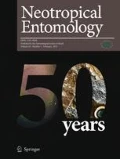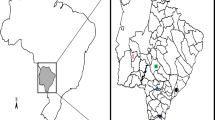Abstract
The aim of this study was to determine the differences between two Grapholita molesta (Busk) populations by applying infrared spectroscopy. Grapholita molesta populations were collected from different regions within Porto Amazonas, Brazil, and Emilia Romagna, Italy. Eggs, fifth instars, pupae, and adults were examined. Pupae and adults were sexed. A spectrophotometer that was set between 400 and 4000 cm−1 range was used to perform 32 scans. The spectra obtained were analyzed using partial least squares (PLS), and external validation of the model was conducted with UnscramblerTM software, Version 9.1 (CAMO Software AS, Oslo, Norway). The results showed the differences between the populations in all of the analyzed stages of maturation. The pupal stage was the most viable stage for reading the beam spectrum, and it was concluded that IR can separate G. molesta biotypes.


Similar content being viewed by others
References
Aldrich BT, Maghirang EB, Dowell FE, Kambhampati S (2007) Identification of termite species and subspecies of the genus Zootermopsis using near-infrared reflectance spectroscopy. J Insect Sci 7:18
Antonialli Junior WF, Lima SM, Andrade LHC, Súarez YR (2007) Comparative study of the cuticular hydrocarbon in queens, workers and males of Ectatomma vizottoi (Hymenoptera: Formicidae) by Fourier transform-infrared photoacoustic spectroscopy. Gen Mol Res 6:492–499
Antonialli Junior WF, Súarez YR, Andrade LHC, Lima SM (2008) Intra- and interspecific variation of cuticular hydrocarbon composition in two Ectatomma species (Hymenoptera: Formicidae) based on Fourier transform infrared photoacoustic spectroscopy. Gen Mol Res 7:559–566
Breniaux D (2001) 2000 fruit trees: year, plant heath review. Phytoma 536:22–25
Cole TJ, Ram MS, Dowell FE, Omwega CO, Overholt WA, Ramaswamy SB (2003) Near-infrared spectroscopic method to identify Cotesia flavipes and Cotesia sesamiae (Hymenoptera: Braconidae). An Entomol Soc Am 96:865–869
Dharmaraj S, Suhaimi Jamaludin A, Mohammad Razak H, Valliappan R, Atinah Ahmad N, Lay Harn G, Ismail Z (2006) The classification of Phyllanthus niruri Linn. according to location by infrared spectroscopy. Vib Spectrosc 41:68–72
Dowell FE, Throne JE, Wang D, Baker JE (1999) Identifying stored-grain insects using near-infrared spectroscopy. J Econ Entomol 92:165–169
Dowell FE, Parker AG, Benedict MQ, Robinson AS, Broce AB, Wirtz RA (2005) Sex separation of tsetse fly pupae using near-infrared spectroscopy. Bull Entomol Res 95:249–257
Fernández RIJ, Carvalho BJC, Pasquini C, Lima GMK, Moura M, Arizaga CGG (2011) Barcoding without DNA? species identification using near infrared spectroscopy. Zootaxa 2933:46–54
Ferreira ME, Grattapaglia D (1998) Introdução ao uso de marcadores moleculares em análise genética. 2ed. Embrapa-SPI, 220 p
Gonzales RH (1986) Phenology of the oriental peach moth. Aconex 12:5–12
Guennelon G, Audemard H, Fremond JC, El Idrissi Ammari MA (1981) Progress achieved in permanent rearing of the codling moth (Laspeyresia pomonella L.) on an artificial medium. Agronomy 1:59–64
Hickel RE (1993) Pragas da ameixeira e do pessegueiro e seu controle no Estado de Santa Catarina. Boletim Técnico n66. Epagri, 66 p
Kirk H, Dorn S, Mazzi D (2013) Worldwide population genetic structure of the oriental fruit moth (Grapholita molesta), a globally invasive pest. Ecology 13:12
Klarica J, Bittner L, Pallua J, Pezzei C, Pezzei HV, Dowell F, Sheed J, Bonn KG, Huck C, Steiner SCB (2011) Near-infrared imaging spectroscopy as a tool to discriminate two cryptic tetramorium ant species. J Chem Ecol 37:549–555
Landis JR, Koch GG (1977) The measurement of observer agreement for categorical data. Biometrics 33:159–174
Lockey KH (1988) Lipids of the insect cuticle: origin, composition and function. Comp Biochem Physiol 89:595–645
Lorenzato D (1988) Lepidópteros nocivos em fruteiras rosáceas no Sul do Brasil. Ipagro 31:7
Mayagaya VS, Michel K, Benedict MQ, Kelleen GF, Wirtz RA, Ferguson HM, Dowell FE (2009) Non-destructive determination of age and species of Anopheles gambiae s.l. using near-infrared spectroscopy. Am J Trop Med Hyg 81:622–630
Mendoza-Perez J, Throne JE, Dowell FE, Baker JE (2005) Detection of insect fragments in wheat flour by near-infrared spectroscopy. J Econ Entomol 39:305–312
Miller CE (2001) Chemical principles. In: Williams PC, Norris K (eds) Near-infrared technology in the agricultural and food industries. Am Assoc Cer Chem, St Paul, pp 19–37
Murray I, Williams PC (1990) Chemical principles of near-infrared technology. In: Williams PC, Norris KH (eds) Near-infrared technology in the agricultural and food industries. Am Assoc Cer Chem, St. Paul, pp 17–34
Okigbo BN (1992) Conservation and use of plant germplasm in African traditional agriculture and land use systems. In: Putter A (ed). Safeguarding the genetic basis of Africa’s traditional crops. Proc Nairobi: CTA/IBPGR/KARI/UNEP 1:15–38
Pan YZ, Lu J, Jiang F (2008) The occurrence of pear piercing moth and its control. South China Fruits 31:77–78
Pasquini C (2003) Near infrared spectroscopy: fundamentals practical aspects and analytical applications. J Braz Chem Soc 14:138–219
Ridgway C, Chambers J (1996) Detection of external and internal insect infestation in wheat by near-infrared reflectance spectroscopy. J Sci Food Agric 71:251–264
Scullion J, Elliott GN, Huang WE, Goodacre R, Worgan H, Darby R, Bailey MJ, Gwynn-Jones D, Griffith GW, Winson MK, Williams PA, Clegg C, Draper J (2003) Use of earthworm casts to validate FT-IR spectroscopy as a ‘sentinel’ technology for high-throughput monitoring of global changes in microbial ecology. Pedobiologia 47:440--448
Song H, Buhay JE, Whiting MF, Crandall KA (2008) Many species in one: DNA barcoding overestimates the number of species when nuclear mitochondrial pseudogenes are coamplified. Proc Natl Acad Sci USA 95:13486–13491
Souferini NV, Selivon D (2000) Genética da associação de insetos com plantas hospedeiras. Oecol Bras 1:423–436
Souza NR (2002) processos genético-evolutivos e os recursos filogenéticos In: Souza NR, Souza AGC (2002) Recursos genéticos na Amazônia ocidental: Conservação, pesquisa e utilização. Embrapa Amazonia Ocidental, Manaus, pp 19--26
Susanta-Behura K (2006) Molecular marker systems in insects: current trends and future avenues. Mol Ecol 15:3087–3113
Torriani MVG, Mazzi D, Hein S, Dorn S (2010) Structured populations of the oriental fruit moth in an agricultural ecosystem. Mol Ecol 19:2651–2660
Van der Geest LPS, Evenhuis HH (1991) Tortricid pests: their biology, natural enemies and control, vol 5 Elsevier, Amsterdam, 808 p
Wenning M, Seiler H, Scherer S (2002) Fourier-transform infrared microspectroscopy, a novel and rapid tool for identification of yeasts. App Env Micro 10:4717–4721
Author information
Authors and Affiliations
Corresponding author
Additional information
Edited by Stefano Colazza – Univ of Palermo
Rights and permissions
About this article
Cite this article
Teixeira, R., Fernandéz, J.I.R., Pereira, J. et al. Identification of Grapholita molesta (Busk) (Lepidoptera: Tortricidae) Biotypes Using Infrared Spectroscopy. Neotrop Entomol 44, 129–133 (2015). https://doi.org/10.1007/s13744-015-0272-y
Received:
Accepted:
Published:
Issue Date:
DOI: https://doi.org/10.1007/s13744-015-0272-y




